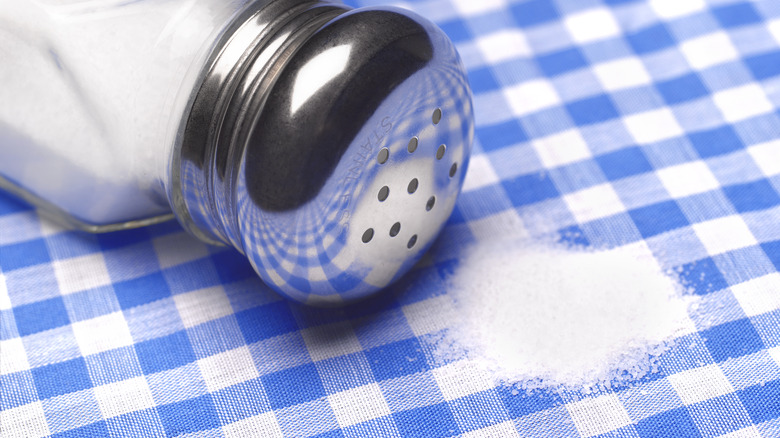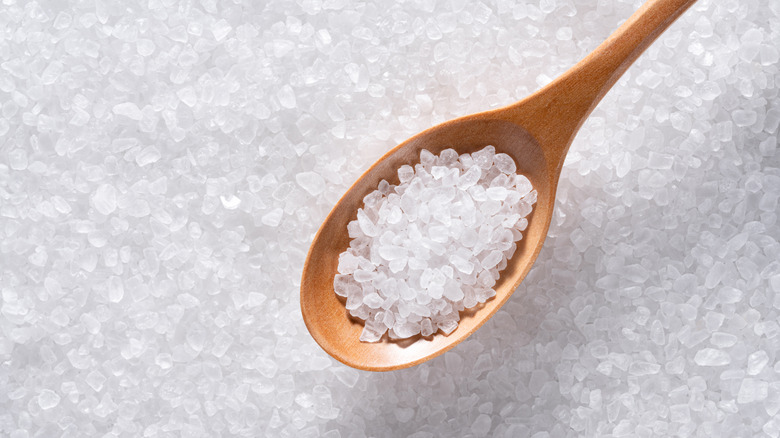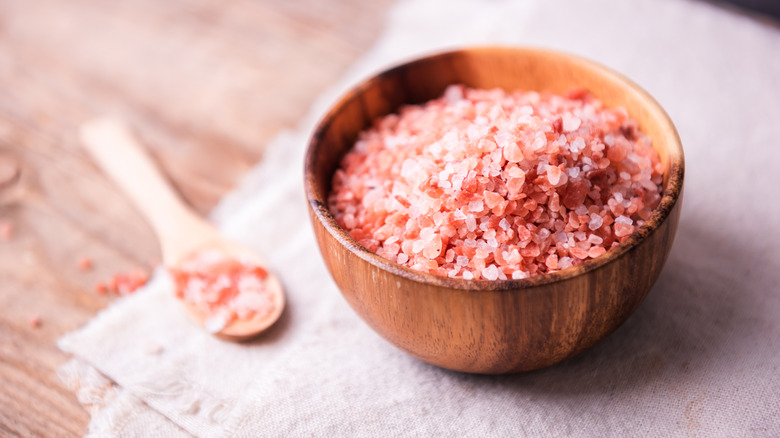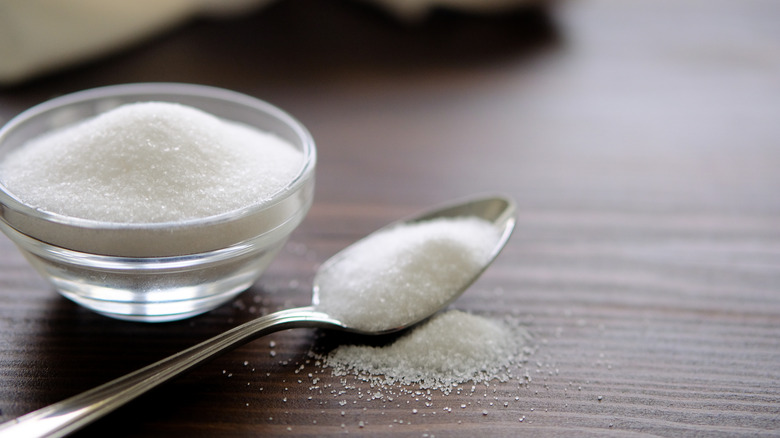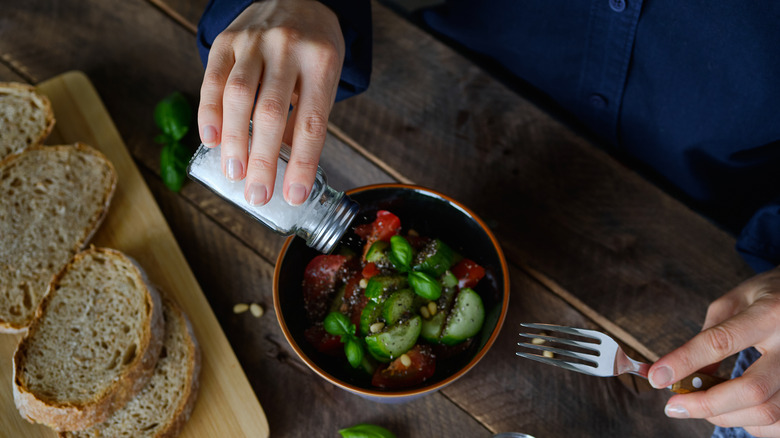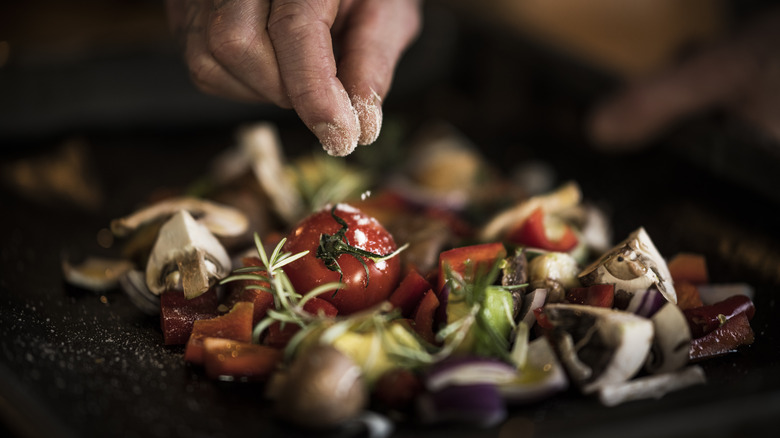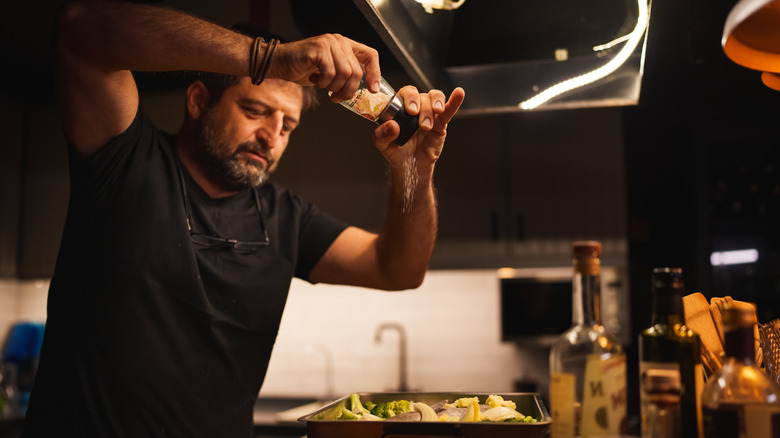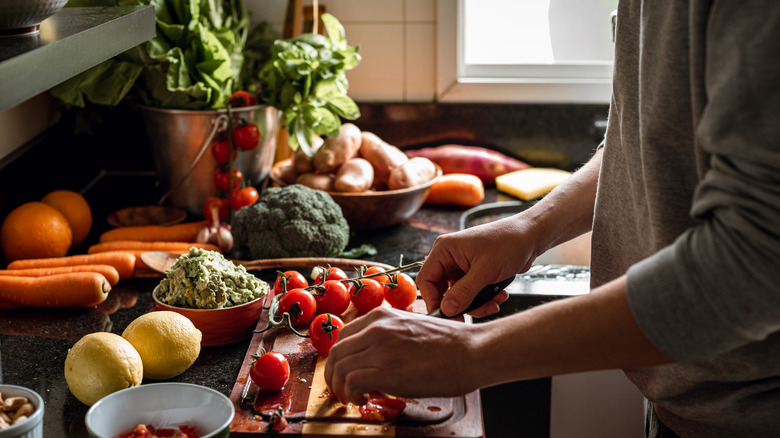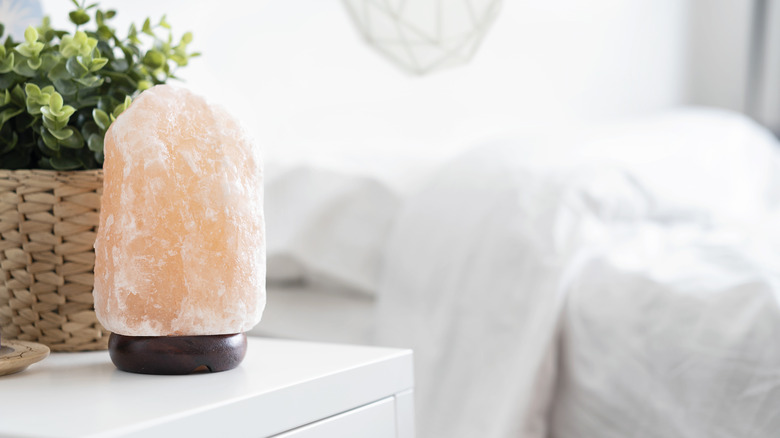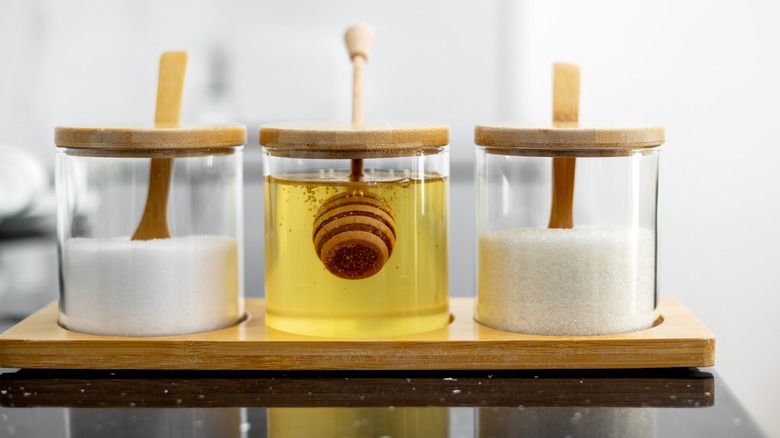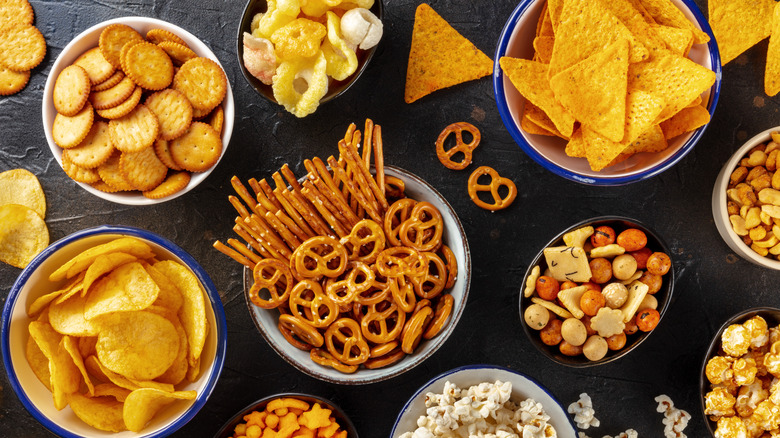Myths About Salt You Thought Were True
For cooks, salt is like air and water: It's absolutely essential, but since it's almost always around, we don't often give it much thought. Rare are the occasions when we shop for it intentionally (unless we come upon an especially pretty variety or eye-catching container), and even rarer are the occasions when we run out of it. And when that happens, we're caught flat footed: How could that have possibly happened?
It wasn't always like this. Salt was once so valuable that the Roman soldiers received it as part of their salaries. And salt plays visible roles in mythology and biblical lore –- for instance, a climactic moment in the biblical fall of Sodom and Gomorrah was when Lot's wife, glancing behind her to peek at the destruction, turned into a pillar of salt. Today, salt is an essential but under-appreciated workhorse is our kitchens, which is a good reason to pay more attention to it and understand how it works. To help us debunk old myths and get the most from our salt shakers, we've asked a couple of experts — registered dietitian Kathleen Garcia-Benson of Top Nutrition Coaching and spice master Lior Lev Sercarz, founder of the global spice brand La Boîte – to share their secrets.
All salt is interchangeable in recipes
Most recipes we encounter call for salt, and most cooks keep a container of it around that they use for everything. The default variety for many home cooks is the cardboard canister of table salt, and it works fine for most applications. However, to get the best flavor from your food, it pays to keep a few varieties of salt around and understand the best uses for each.
Table salt, as its name implies, is ideal for last-minute flavoring, as well as for baking (even sweet treats such as oatmeal cookies need a touch of salt for balance). Kosher salt has larger grains, and while some recipes specifically call for kosher salt, be aware that not all brands are interchangeable –- for instance, Morton's kosher salt is denser with a more concentrated saltiness than Diamond Crystal, so switching out one for the other can change the flavor of your dish. While serious home cooks enjoy larger-grained salt for its prettiness and crunch, Lior Lev Sercarz notes it's not the right salt for everything. "Using very large flakes is also not always appropriate," he explained. "For example, if you pre-season a steak with large flake salt, it won't adhere to the meat and likely just fall into the grill or oven. This means it won't have the flavor effect you desire, and you've just wasted a lot of salt." Instead, use table salt for pre-seasoning and fancy sea salt as a garnish for your perfectly grilled steak.
Himalayan pink salt is healthier than table salt
An eye-catching salt variety you've likely seen in recent years is Himalayan pink salt –- large, rosy crystals that often come in their own grinder bottle. It's certainly pretty, both in the bottle and on the plate, which makes it a fun gift for the foodies in your life. And while some fans claim it has a more floral flavor than other rock salts, others find little or no difference in flavor. In addition, perhaps because of its otherworldly appearance, Himalayan sea salt has gained a reputation in some circles for having special nutritional powers.
Unfortunately for fans of the salt, however, this is not true, at least not on a practical level. "Himalayan and other specialty salts often contain various other essential micronutrients, but from a nutritional standpoint, they are quite similar to regular table salt," Kathleen Garcia-Benson explained." While these minerals may offer some benefits, they are typically present in such small amounts that a well-rounded, nutrient-dense intake can typically meet these needs." For those who want to ensure their salt offers good nutritional value, Garcia-Benson recommends iodized table salt. "I sometimes recommend my clients keep both iodized and specialty salts on hand, alternating between them to enjoy the best of both worlds," she said. "However, if you choose to switch exclusively to non-iodized salts, it's important to ensure you're getting sufficient iodine from other sources like fish, dairy, or seaweed."
You can store salt anywhere
Most home cooks know that salt is a preservative — it's a key ingredient in pickles and in dried foods such as jerky. So since salt makes other foods more durable and shelf stable, we tend to assume that salt itself is bulletproof, store it anywhere that's convenient, and assume it'll be just fine. And for the most part, it will be. However, to preserve the texture of your salt and ensure it doesn't pick up any stray crumbs or other contaminants, you should remember to treat it with respect.
For instance, while salt bowls with cute little matching spoons may be fashionable, they're not great for the salt, especially if you live in a humid area. "Salt should be stored in a container or jar with an air-tight lid because it's important to avoid humidity," Lior Lev Sercarz said. "Salt is a great absorbing agent, but humidity will cause it to clump up, which obviously is not what you want when you're planning to consume it or use it to flavor a dish." Sercarz added that just as you'd wash your hands before handling other food, you should do the same with salt. "It's important to make sure your hands are clean and completely dry before you go to seal and store your salt so that no water or humidity is sealed within the container," Lev Sercarz added.
Everyone should eat less salt
Americans have a love-hate relationship with salt. On one hand, we love our chips, hot, salty fries, and other savory snacks. On the other, we're constantly scolding each other (often while holding a bag of pretzels) for eating too much salt and fretting about how high-sodium diets are beyond bad for you. There's some truth to this: Salty diets have been linked to high blood pressure, for instance.
However, it's not the case that salt is always unhealthy — some salt is actually necessary for our health. "Salt (sodium chloride) is an essential mineral that helps maintain the sodium-potassium pump, which is involved of various cellular processes, including nerve impulses and muscle contraction," Kathleen Garcia-Benson said. "While people with high blood pressure often benefit from reducing sodium in their diet, contributing to lower blood pressure, this effect is often enhanced by other healthy lifestyle changes." Moreover, too little salt can be a problem, too. "There are instances where a higher sodium intake is beneficial. Athletes engaging in prolonged training sessions or those who sweat heavily, especially in hot climates, may need to consume more sodium to replenish what is lost in sweat," Garcia-Benson said. "It's also important to note the risk of hyponatremia — a potentially life-threatening condition that can occur when salt intake is too low and excessive amounts of water are consumed."
If you over-salt your food, you can fix with by adding a slice of bread
Few cooking experiences are more frustrating than putting hours of love into a special dish, such as a long-simmered stew, only to screw it up with too much salt. Everyone who cooks regularly has been through this, and community cookbooks are filled with folk remedies to solve the problem. Some of these involve adding an extra, neutrally flavored ingredient, such as a slice of bread or raw potato pieces, to the pot to absorb the excess salt.
Unfortunately, once you've incorporated salt into a dish, you're not going to be able to get it out again. The only thing added ingredients can do is potentially balance the flavors so the saltiness doesn't seem as extreme. "It is hard to fix something that is over-salted," Lior Lev Sercarz said. "My recommendation would be to add or serve a sauce or condiment with high acidity. Acidic ingredients, as well as heat and sweetness, will help neutralize the salinity of the meat, and that is usually the best way to balance taste."
If you have high blood pressure, cutting back on salt will correct it.
People with high blood pressure have long been told to stick to low-sodium diets, and ample scientific evidence shows this is a smart move. When high quantities of sodium occur in the bloodstream, our bodies retain water to dilute the concentration of sodium. This results in a higher volume of blood in the blood vessels, which raises the pressure the blood exerts against the vessel walls. Obviously, this isn't a good thing, and a low sodium diet can help prevent this from happening.
But while moderating your sodium intake is wise, it may not be the silver bullet to cure your blood pressure problems. "A common misconception is that all high blood pressure is due to high salt intake. In reality, factors like genetics, overall diet, stress levels, and physical activity also play significant roles in influencing blood pressure," Kathleen Garcia-Benson said. "When individuals are diagnosed with high blood pressure, they often focus exclusively on reducing their salt intake. While this can be beneficial, it's equally important to consider increasing nutrients like potassium, which also play a crucial role in managing blood pressure. Potassium helps balance the effects of sodium; a balanced diet and sustainable healthy lifestyle changes is often more effective than simply reducing salt," Garcia-Benson elaborated.
You should always keep salt by the stove for convenience
No matter what cooking style or cooking method you choose for your meal prep, chances are you're going to need some salt. And because many recipes call for the cook to add seasonings early in the cooking process and adjust them at the end, we often store our salt close to where we most commonly use it: right by the stove. But while this is intuitive and convenient, it can compromise the quality of your salt.
As Lior Lev Sercarz explained, salt easily absorbs moisture from the environment, so the steamy environment by a hot stove can cause it to clump. And the heat won't help either. "It's also important to ensure [salt is] kept in a room-temperature environment and away from your stove, where heat can compromise its consistency and texture," he said. So instead of storing your salt by the stove, keep it in a nice dry spot and pour out just the amount you need to bring to the stove when you start cooking.
To get the right amount of salt, just follow the recipe
Novice cooks often hear the advice "just follow the recipe" and follow it scrupulously. It's solid advice, and if you work from a well-written recipe, you'll almost certainly get respectable results. Still, some cooks follow every step religiously and wonder why their food lacks a certain something — or tastes different from the last time they made it.
This is because while recipes stay the same, the flavor of ingredients can vary. Fruits, vegetables, and even some types of meat can taste different at different times of the year — there's a reason summer tomatoes are sought after while winter ones aren't. And because of this, you may need to adjust your seasoning accordingly, even if it means using a little more or less salt than the recipe officially requires. So follow the recipe, but also trust your palate. "Taste as you go but also remember that most meats can tolerate quite a bit of salt since they will be cooked with heat before served," Lior Lev Sercarz said.
It doesn't matter when you add salt to your food
Timing matters when it comes to adding salt to your food. Your goal is to season your food so that every bite has just the right balance of salt all the way through. So for some foods, such as large cuts of meat, it's wise to add salt well before cooking to allow it to penetrate fully. "At La Boîte, we love to pre-season our meats with salt as much as a day before," Lior Lev Sercarz said. "There's a notion that if you add salt ahead of time, your meat will start rendering liquid. This doesn't happen. We recommend rubbing your meats with salt ahead of time for more flavor."
Salt, however, not only adds flavor to meat but affects its texture, so in some cases pre-salting can have negative effects. "With that said, there are two exceptions among meats where it's important to use less salt and not to add it at all until you're ready to cook it," Sercarz said. "With poultry, salt will start curing the meat if you add it before you're prepared to cook it. With ground meat (beef, lamb, or pork), salt can begin to cause discoloration and may also slightly cure [it]. It is preferable with ground meat and poultry that you add salt right before cooking."
Salt rooms and salt lamps have proven health benefits
Over the last few years, salt has become trendy as a part of wellness routines as well as an essential seasoning. You've likely seen salt lamps — rocky chunks of Himalayan pink salt that glow from within. Or perhaps you've heard of or visited salt rooms, which are literally just rooms whose floors and walls are lined with rock salt. Both are supposed to offer a range of health benefits, from improved respiration to better sleep, and in the case of salt lamps, better air quality in your home.
But while the lamps are pretty and salt rooms can offer a pleasant respite from everyday stressors, they're not the miracle cures some believe them to be. "As with any peaceful environment, salt lamps and salt rooms can play a role in reducing stress levels, however evidence on the presence of the salt itself causing benefits is inconclusive," Kathleen Garcia-Benson said. "Many of the positive effects people report could be linked to the placebo effect rather than any direct physiological impact from the salt. There is some research that salt rooms may be beneficial for those with respiratory conditions by helping to clear airways. However, more studies are needed to fully understand these effects, and salt therapy should not be seen as a replacement for conventional medical treatments."
Salt never goes bad
Technically, it's true that salt can last forever – at least if it's kept dry. Salt has powerful antimicrobial properties, which is a reason it works so well as a food preservative. And it's also the reason pure, dry salt can't harbor the types of bacteria that can lead to food poisoning. However, in the real world of home kitchens, an ordinary container of salt is likely to be exposed to moisture and potentially to contaminants (such as your dirty fingers).
This means that real-world salt can go bad. If exposed to moisture, salt can clump, and it's possible for an open box to harbor unwanted critters. While they won't last long in there, you still don't want them in your food. And flavored salts, such as garlic salt, will lose their punch after a few years. The good news is that clumpy, unattractive salt won't hurt you and is still safe to cook with. But if the texture of salt matters to you as much as its flavor, keep your salt in a safe, moisture-free environment.
If a food doesn't taste salty, it's low in salt
Those trying to control their salt intake often focus their efforts on the usual suspects — obviously salty foods such as crackers, chips, and canned soups. They may also make intentional efforts to minimize the amount of salt they use when cooking. While these steps are beneficial, careful eaters are often unaware that other common foods can contain high quantities of salt — and often, these foods don't taste especially salty.
"Typical restaurant meals often contain more salt than one might expect, significantly contributing to daily intake levels," Kathleen Garcia-Benson said. "Other unsuspecting foods high in salt include breads, canned vegetables, salad dressings, cottage cheese, and packaged dressings and marinades." And if you want more depressing news, your efforts to make healthier choices may be adding sodium to your diet. "Additionally, some 'diet' or reduced-fat versions of foods may have increased salt content, as manufacturers often add extra sodium to enhance flavor that may be lost when reducing sugar or fat," Garcia-Benson said.
